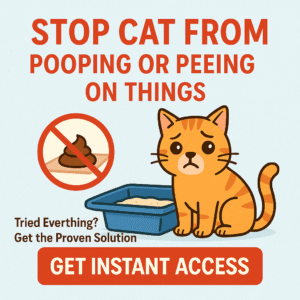When your cat starts peeing in the house, it’s rarely out of spite—it’s almost always a cry for help. Whether it’s stress, health issues, litter box problems, or marking, there’s a solution you can take today to fix it—for good. This comprehensive guide shows you how.
And the Cat Spray No More ebook offers the step-by-step tools, routines, and confidence you need to support behavior change—no guesswork, just clarity.
1. Don’t Delay—Check Health First
Key thing: Medical issues like UTIs, bladder crystals, kidney problems, arthritis, or diabetes often cause inappropriate urination. Your cat might avoid the litter box due to pain or discomfort.
- Schedule a vet visit with urinalysis and blood work.
- Treat infections, crystals, inflammation, or kidney disease aggressively.
- Many cats stop urinating outside the box once pain is managed.
2. Litter Box Setup Is Make-or-Break
Even healthy cats can avoid a box they dislike. Focus on four essentials:
🧼 Quantity & Cleanliness
- One box per cat + one extra—multiple accessible locations.
- Scoop daily; fully wash with unscented soap weekly.
🛁 Size & Design
- Choose open, low-sided boxes—no lids or cramped spaces.
- Select large boxes to allow comfortable turning.
🧂 Litter Type
- Use unscented, fine-grain, clumping litter.
- Experiment (one box at a time) to identify preferences.
📍 Placement
- Locate boxes in quiet, private areas—not near noisy appliances.
- Place a box on each floor to avoid obstacles.
3. Stress & Environmental Factors
Cats often pee outside the box when stressed. Common triggers include:
- New people or pets
- Home renovations or loud noise
- Neighbor cats visible through windows
- Disrupted routines
Relief tips include:
- Pheromone diffusers like Feliway in problem areas
- Quiet hiding spots or vertical perches
- Consistent feeding, play, and cleaning times
4. Determine Accident vs Territorial Marking
- Accidents: Horizontal surfaces (beds, carpets), no spray posture. Likely avoidance due to stress or box issues.
- Marking: Vertical areas, tail up and twitching. Usually territorial intent—spay/neuter helps reduce marking pressure.
Use different strategies depending on which type it is.
5. Clean Deep—Scent Matters
Even tiny urine residues can attract repeats. Surface cleaning won’t eliminate the scent:
- Use enzyme-based cleaners designed for pet urine.
- Saturate the entire affected area, then let air dry fully.
- Protect carpets temporarily with absorbent pads until scent is gone.
6. Redirect & Reinforce Positive Behavior
- Catching your cat heading to pee? Gently redirect to the litter box.
- Immediately reward successful litter box use with praise or a treat.
- Avoid punishment—it increases stress and delays progress.
7. Make Your Home Cat-Friendly
- Spread boxes across floors and quiet rooms.
- Add vertical perches, hiding nooks, climbing trees.
- Provide puzzle feeders or interactive toys to reduce boredom.
8. Structure & Tracking with Routine
The Cat Spray No More ebook helps create monitoring systems—perfect even for peeing issues:
- Incident logs: Record time, place, and possible triggers.
- Cleaning calendars: Ensure regular box maintenance.
- Behavior-based reminders: Feeding, play, litter checks—all in one place.
9. When to Seek Professional Help
- Urination outside the box continues 2+ weeks despite actions taken.
- Marking behaviors persist despite spaying/neutering and environmental adjustments.
- Accompanied by weight loss, appetite changes, or visible discomfort.
- Complex factors—multi-cat stress or ongoing trauma.
Consult a certified veterinary behaviorist or cat behavior consultant for personalized plans.
10. Real-Life Turnaround
“Our Tabby, Max, began peeing on the living room rug after a neighbor’s new cat appeared outside. Vet cleared him medically. We deep-cleaned with enzymes, added another box upstairs, blocked window view, and installed Feliway diffuser. Using the ebook’s tracking charts kept us on schedule. Within 5 days, the rug stayed dry—and Max visits his box every time.”
14-Day Rescue Blueprint
| Days | Focus Area | Actions |
|---|---|---|
| 1–2 | Medical & Cleaning | Vet check, deep-clean all urine areas with enzyme cleaner |
| 3–5 | Box Overhaul | Add appropriate boxes, refill fresh litter, set scooping routine |
| 6–9 | Stress Relief | Install pheromones, create perches, maintain routine |
| 10–14 | Training & Reinforcement | Redirect to box, reward success, track incidents daily |
| 15+ | Continue & Monitor | Weekly cleaning, environment checks, consult if needed |
Signs You’re Winning
- Within a week: Fewer accidents, improved box use
- Week 2–4: Dry house, no repeats, routine habits
- 1–2 months: Solid behavior patterns, calm and confident cat
- 3+ months: Problem resolved—home stays clean, cat stays happy
Final Thoughts: Compassion & Consistency Win
Cat peeing in the house is always a meaningful signal—a need. With veterinary care, thoughtful litter setups, environmental enrichment, and structured routines (like those in Cat Spray No More), you can help your cat return to healthy habits quickly and permanently.
Download Cat Spray No More now and get your home—and your cat—back to harmony. Practical tools, clear guidance, and gentle support all in one perfect guide.
